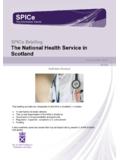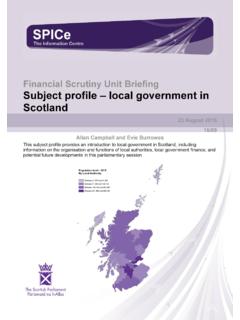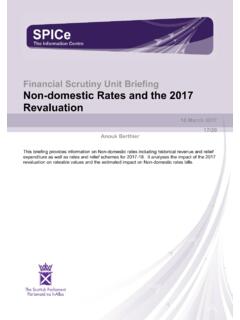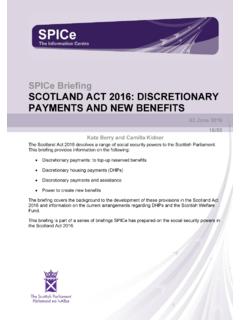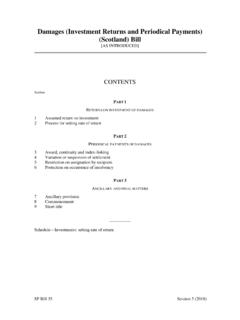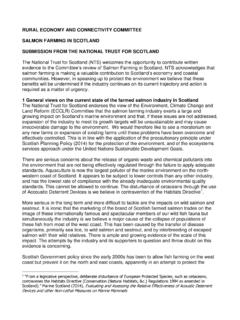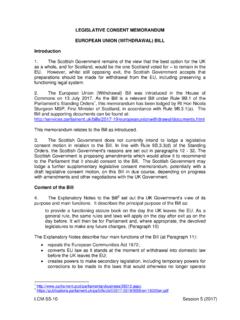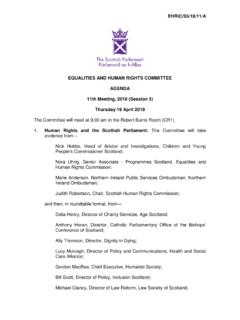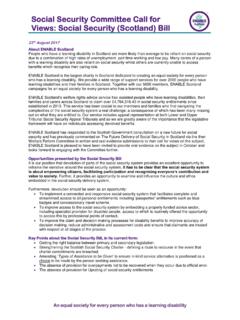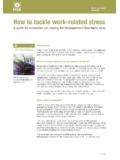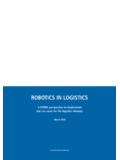Transcription of Scottish North Sea oil and gas industry
1 The Sc ot tish Parliament and Scottis h Parliament I nf or mation C entre l ogos . Financial Scrutiny Unit briefing Scottish North Sea oil and gas industry 23 April 2014 14/28 Greig Liddell This briefing is produced to assist the Economy, Energy and Tourism Committee in their inquiry into Scotland s Economic Future Post-2014. It provides a summary of key statistics at a pivotal moment in the economic history of the industry , when both record investment levels and continued production decline have been witnessed in recent years. The briefing also considers the impact of the industry on the Scottish economy and the UK public finances since 1976, and discusses some of the policies and forecasts which will inform the political debate surrounding the sector over the coming months and years. 2 CONTENTS INTRODUCTION .. 3 HISTORY .. 4 PRODUCTION HISTORY .. 5 TAX REVENUES FROM UKCS SINCE 1980.
2 6 OIL PRICES SINCE 1976 .. 7 CONTRIBUTION TO SCOTLAND S ECONOMY .. 9 CONTRIBUTION TO Scottish GDP .. 9 THE FLOW OF North SEA OIL .. 11 IMPACT ON SCOTLAND S BALANCE OF TRADE .. 13 EMPLOYMENT AND SKILLS .. 14 CURRENT TAX REGIME .. 15 THE FUTURE OF THE industry .. 17 INVESTMENT .. 17 REMAINING RESERVES .. 18 OPERATING COSTS .. 19 THE WOOD 20 DECOMMISSIONING COSTS AND TAX IMPLICATIONS .. 21 CARBON EMMISSIONS TARGETS AND THE CARBON BUBBLE .. 22 ANNEX 1: THE BOUNDARY ISSUE .. 23 SOURCES .. 24 RELATED BRIEFINGS .. 28 3 INTRODUCTION The discovery and exploitation of North Sea oil and gas has been one of the most important episodes in the post-Second World War economic history of the UK (Kemp, 2013). After more than four decades the industry continues to invest and produce at levels unimaginable to most early forecasters. Indeed, Department of Energy economists in the 1970s calculated total reserves of between and 14 billion barrels on the UK Continental Shelf.
3 So far almost 42 billion boe (barrel of oil equivalent) have been recovered, with estimates of remaining reserves ranging between 15 and 24 billion boe (Kemp, 2013). Professor Alex Kemp of the University of Aberdeen predicts that oil and gas extraction could continue on the UK Continental Shelf (UKCS) beyond 2040. The contribution oil and gas have made to the economy and the public finances of the UK, as well as its impact on the political culture of Scotland, continue to be debated. This briefing aims to assist the on-going debate, particularly in light of the Economy, Energy and Tourism Committee s decision to hold an inquiry into Scotland s economic future post-2014. It is hoped that this summary of key figures and policies will assist Members of the Scottish Parliament to understand the past, present and future of one of Scotland s most successful industries, particularly at this pivotal moment when both decreasing production and record levels of investment are seen on the UKCS.
4 4 HISTORY Onshore gas discoveries during the 1940s and 1950s mainly in Dorset, the East Midlands and Groningen in the Netherlands - led geologists to conclude that the UK continental shelf (UKCS) under the North Sea probably contained a substantial volume of hydrocarbons. Subsequent seismic surveying throughout the 1960s yielded initial fruit in the form of the Southern North Sea gas province (in the seas off Great Yarmouth). Exploration continued northwards and, in December 1969, Phillips Petroleum discovered oil at Ekofisk, within the Norwegian sector of the central North Sea. This was followed by the discovery of the Montrose oil field, 135 miles east of Aberdeen, in December 1969, as well as BP s Forties field in October 1970. Further discoveries were made in 1971 and 1973, with the discovery of the massive Brent oil field, east of Shetland, and the Piper field, east of Orkney (Kemp, 2013).
5 The development of the North Sea as an oil producing province required capital investment rarely seen in Britain since the 19th Century. In 1976, for example, investment in the UKCS was 13 billion (in 2013 prices), the equivalent of 33% of all UK investment in the manufacturing sector that year (Kemp, 2013). In 1972, Shell Exploration and Production Limited estimated the cost of developing a field over a ten year period to be around 250 million in the money of the day ( in today s money) as much as a space shot to the moon (SCDI, 1972). The environment in which fields were discovered and developed made the achievements of the engineers, drillers, geologists and rig operators all the more impressive. Oil first flowed ashore from the Argyll field in June 1975 and, within a decade, million barrels of oil per day were being extracted from 29 fields. As well as being one of our most capital-intensive industries, the oil and gas industry has also been a major employer in Scotland since the late 1970s, particularly in and around Aberdeen, the Oil Capital of Europe.
6 According to the Scottish Council for Development and industry (SCDI), the sector supports over 200,000 jobs in Scotland (SCDI, 2013). The safety of those employed in the sector came into sharp focus after the Piper Alpha disaster of July 1988, when 167 men lost their lives in the world s worst off-shore disaster. The subsequent Cullen Inquiry into the disaster presented a number of recommendations, including the transfer of offshore safety regulation to the Health and Safety Executive (HSE). On average, off-shore workers are now less likely to suffer serious injury than those employed in transport, construction, manufacturing or retail sectors (HSE 2013) Nevertheless, the health and safety implications of a workplace described by one senior HSE official as a heliport, on top of a hotel, on top of a power station, on top of a process plant on top of an oil well, in the middle of the North Sea are immense (HSE, 2013).
7 If Piper Alpha saw a rethinking of offshore safety, the Brent Spar episode of 1995 highlighted the environmental impact of an industry starting to deal with ageing infrastructure. Shell UK, with Department of Trade and industry approval, intended to sink a 147 metre high storage tank containing tonnes of toxic chemicals in the North Atlantic (Harvie, 1995). Greenpeace and other environmentalists across Europe launched a high-profile, and ultimately successful, campaign, forcing Shell to reverse its decision. The company then opted to dismantle the Spar in Norway at a cost of 43m compared to the dumping option, which would have cost the company (BBC 1998). With decommissioning costs estimated at 40 billion between now and 2040 there are serious implications for the industry and government, some of which are discussed in more detail in the final chapter of this briefing .
8 5 PRODUCTION HISTORY In 2012, the UK was the largest oil producer and second largest gas producer in the European Union, or the 23rd largest in the world for oil and gas combined (22nd for oil, 21st for gas) (DECC, 2014a). Nevertheless, it is accepted that total North Sea oil and gas production on the UKCS peaked in 1999 and has been declining each year since. Chart 1 shows crude oil extraction levels, as measured by millions of barrels, for each year since 1976. In 1985, production of crude was averaging million barrels of oil per day and in 1999 - the year of peak production production rates were even higher, at million barrels per day. Barrel of oil equivalent per day (boepd) levels are now about 30% of what they were 14 years ago with DECC figures showing the most dramatic annual reductions taking place in 2010 and 2011. Even before 2010 production had been falling by between 5 and 10 per cent annually over the decade.
9 Recently published figures for 2013 show that production continued to decline during 2012 and 2013 with an average of million barrels of oil equivalent per day (boepd) produced in 2013, eight per cent lower than in 2012 (Oil & Gas UK, 2014). Despite this, production from the UK Continental Shelf (UKCS) still met 62% of the UK s oil demand and 50% of its gas demand in 2013 (DECC, 2014b) Chart 1: Barrels of crude oil per year (million) 02004006008001,0001,20019761981198619911 996200120062011 Source: DECC 2013 How much of this production has taken place on the Scottish section of the UKCS since 1976 depends on the demarcation method used to determine the offshore border. Accepting the median line demarcation as preferred by the Scottish Government (see map and explanation in Annex 1), oil/natural gas liquids (NGL) production on Scotland s section of the UKCS averaged 93% of the UK total over the previous fifteen years, in terms of both volume and total value ( Scottish Government, 2013a) Gas production on the Scottish UKCS averaged 54% of the UK total over the same period, with Scotland s section of the UKCS responsible for 46% of total UK gas production in 2012 ( Scottish Government, 2014a).
10 6 TAX REVENUES FROM UKCS SINCE 1980 Table 1 shows the value of tax receipts from oil and gas activities on the UKCS each year since 1975 in 2012-13 prices. Revenues peaked in 1984-85 (in real terms) and fell dramatically during the late 1980s, remaining relatively low throughout the 1990s. Since 2000-01 revenues remained above the 5bn mark, rising to over 10bn during four of the last ten years prior to 2013-14. In total, over the past four decades, corporate taxes from the UKCS have contributed over 300bn to the UK Treasury (in today s money). This sum includes Petroleum Revenue Tax (PRT), Ring Fence Corporation Tax (RFCT) and Supplementary Charge (SC) revenue, as well as the Gas Levy (abolished in 1998) and Royalties (abolished 2003). Table 1: Total UK receipts from UKCS since 1975 Year m (2012-13 prices) Year m (2012-13 prices) Year m (2012-13 prices) 1975-76 147 1988-89 6,049 2001-02 7,136 1976-77 420 1989-90 4,236 2002-03 6,563 1977-78 1,085 1990-91 3,860 2003-04 5,380 1978-79 2,322 1991-92 1,535 2004-05 6,341 1979-80 8,149 1992-93 2,002 2005-06 11,351 1980-81 11,151 1993-94 1,837 2006-07 10,490 1981-82 17,651 1994-95 2,431 2007-08 8,552 1982-83 19,915 1995-96 3,298 2008-09 13,917 1983-84 21,455 1996-97 4,668 2009-10 6,471 1984-85 27,946 1997-98 4,681 2010-11 8,863 1985-86 25,019 1998-99 3,437 2011-12 11,712 1986-87 10,248 1999-2000 3,450 2012-13 6,530 1987-88 9,392 2000-01 6,009 Source.
